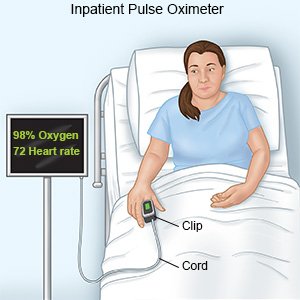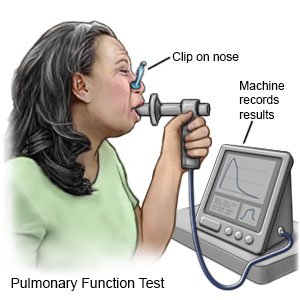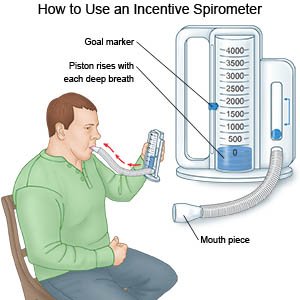Chronic Bronchitis
Medically reviewed by Drugs.com. Last updated on Aug 4, 2025.
Chronic bronchitis is a long-term swelling and irritation of the airways in your lungs. The irritation may damage your lungs. The lung damage often gets worse over time, and is usually permanent. Chronic bronchitis is part of a group of lung diseases called chronic obstructive pulmonary disease (COPD).
 |
WHILE YOU ARE HERE:
Informed consent
is a legal document that explains the tests, treatments, or procedures that you may need. Informed consent means you understand what will be done and can make decisions about what you want. You give your permission when you sign the consent form. You can have someone sign this form for you if you are not able to sign it. You have the right to understand your medical care in words you know. Before you sign the consent form, understand the risks and benefits of what will be done. Make sure all your questions are answered.
Monitoring:
- A pulse oximeter is a device that measures the amount of oxygen in your blood. A cord with a clip or sticky strip is placed on your finger, ear, or toe. The other end of the cord is hooked to a machine. Never turn the pulse oximeter or alarm off. An alarm will sound if your oxygen level is low or cannot be read.

- A heart monitor is an EKG that stays on continuously to record your heart's electrical activity.
Tests:
- Blood tests will show if you have an infection.
- Arterial blood gases (ABGs) show the amount of oxygen and carbon dioxide in your blood. The results can tell your healthcare provider how well your lungs are working.
- Bronchoscopy is a procedure to look inside your airway and learn the cause of your bronchitis. A bronchoscope (thin tube with a light) is inserted into your mouth and moved down your throat to your airway. You may be given medicine to numb your throat and help you relax during the procedure. Tissue and fluid may be collected from your airway or lungs to be tested.
- X-ray or CT pictures may show an infection or lung damage. You may be given contrast liquid to help the lungs show up better in the pictures. Tell the healthcare provider if you have ever had an allergic reaction to contrast liquid.
- Lung function tests are used to find how well your lungs work. Spirometry measures the airflow into and out of your lungs. A lung volume test measures the amount of air your lungs can hold. The amount of oxygen that gets into your blood when you breathe may also be measured.

- A sputum sample is collected in a cup when you cough. The sample is sent to a lab to be tested for the germ that is causing your bronchitis. It can also help your healthcare provider choose the best medicine to treat the infection.
Related medications
Medicines:
- Bronchodilators help open your airways so you can breathe easier. Your medicine is given in a mist form so that you can breathe it into your lungs. Your medicine may be delivered through an inhaler or through a mask attached to oxygen. Ask your healthcare provider to show you how to use your inhaler correctly.
- Steroids help decrease inflammation in your airway so that you can breathe easier.
- Antibiotics treat a bacterial infection.
Treatment:
- Extra oxygen may be needed if your oxygen level is low. Oxygen may be given through a face mask or a nasal cannula.
- Deep breathing and coughing will decrease your risk for a lung infection. Take deep breaths and cough 10 times each hour. Take a deep breath and hold it for as long as you can. Let the air out and then cough strongly. Deep breaths help open your airway. You may be given an incentive spirometer to help you take deep breaths. Put the plastic piece in your mouth and take a slow, deep breath. Then let the air out and cough. Repeat these steps 10 times every hour.

- Postural drainage uses body position and gravity to help bring up sputum (mucus) from your lungs. Your healthcare provider will place you in different positions to help the sputum drain to larger air passages. This helps you cough it out more easily. Your provider may also lightly clap on your back and chest with open hands. Your provider may put a small machine that vibrates on your skin. This breaks up the sputum in your lungs, making it easier to cough up. Postural drainage may make it easier for you to breathe, decrease the chance of infection, and help you get better faster.
- Noninvasive positive-pressure ventilation, or NPPV, may be used to help you breathe. A machine helps your lungs fill with air by using a mask or a mouthpiece. If a mask is used, it may go over your nose and mouth, or just your nose. Extra oxygen may be given to you through the machine.
- A ventilator is a machine that gives you oxygen and breathes for you when you cannot breathe well on your own. An endotracheal (ET) tube is put into your mouth or nose and attached to the ventilator. You may need a trach if an ET tube cannot be placed. A trach is a tube put through an incision and into your windpipe.
Treatment options
The following list of medications are related to or used in the treatment of this condition.
RISKS:
- Over time, chronic bronchitis may cause pain, trouble sleeping, or anxiety. You may need to use oxygen to help you breathe. You may lose weight without trying. Your risk for lung cancer is increased. A lung infection may be life-threatening.
- Advanced chronic bronchitis may lead to heart problems. This happens when the heart has to work harder because of damage to your lungs. You may get swelling in your ankles, legs, or abdomen. You may have blood pressure problems or chest pain.
CARE AGREEMENT:
You have the right to help plan your care. Learn about your health condition and how it may be treated. Discuss treatment options with your healthcare providers to decide what care you want to receive. You always have the right to refuse treatment.© Copyright Merative 2025 Information is for End User's use only and may not be sold, redistributed or otherwise used for commercial purposes.
The above information is an educational aid only. It is not intended as medical advice for individual conditions or treatments. Talk to your doctor, nurse or pharmacist before following any medical regimen to see if it is safe and effective for you.
Learn more about Chronic Bronchitis
Treatment options
Care guides
- Acute Bronchitis
- Acute Bronchitis in Children
- COPD (Chronic Obstructive Pulmonary Disease)
- Chronic Bronchitis
Symptoms and treatments
Medicine.com guides (external)
Further information
Always consult your healthcare provider to ensure the information displayed on this page applies to your personal circumstances.
